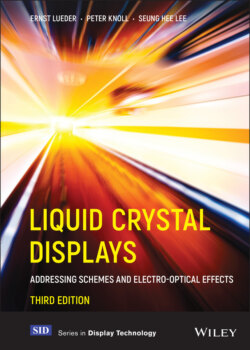Читать книгу Liquid Crystal Displays - Ernst Lueder - Страница 17
2
Liquid Crystal Materials and Liquid Crystal Cells 2.1 Properties of Liquid Crystals 2.1.1 Shape and phases of liquid crystals
ОглавлениеMost liquid crystals consist of molecules shaped like the rod in Figure 2.1(a). The direction of the long axis is called the director, given by the vector n, which is an apolar vector as and are equivalent. Rod-shaped molecules are also termed calamitic. Other shapes of molecules are disc-like or discotic, as in Figure 2.1(b), and lath-like.
We focus on calamitic (Bahadur, 1990; Demus et al., 1998a,b) liquid crystals as they are the most important for applications. Below the melting point Tm they are solid, crystalline and anisotropic, whereas above the clearing point with temperature Tc > Tm they are a clear isotropic liquid. In the mesophase in Figure 2.2 in between Tm and Tc, the material has the appearance of a milky liquid, but still exhibits the ordered phases shown in Figure 2.2. These phases are now described in the sequence given by increasing temperature. The first phase above Tm is the smectic C phase (smectic is derived from the Greek word for soap). As all smectic phases, it is ordered in two dimensions. The molecules are arranged with random deviations tilted to the plane of the layer. In the smectic A phase the directors of the molecules are again with random deviations perpendicular to the plane of the layer. Next to the clearing point, the nematic phase appears with only a one-dimensional order (nematic in Greek means a thread, indicating the thread-like defects in the material). All members of the mesophase are anisotropic, as is the solid phase.
Some other phases of minor importance for display applications are below the smectic C phase, the smectic Bhex phase (hexatic B phase), with the same layers as smectic C but a short-range close-packed hexagonal structure, in Figure 2.3(a) seen against the director ; in this direction, the smectic C phase exhibits the irregular structure in Figure 2.3(b). The phases J, G, E, K and H are located above Tm, and are smectic-like soft crystals with a long range order.
Figure 2.1 (a) Rod-like or calamitic liquid crystal molecule with director n; (b) disc-like or discotic liquid crystal molecules
The smectic C* phase (chiral smectic C phase) in Figure 2.4 possesses a layered smectic structure in which the parallel directors of the molecules are rotated from layer to layer on the surface of a cone, resulting in a helix.
If chiral compounds such as cholesterol esters are added, the nematic phase changes to the cholesteric phase in Figure 2.5, which exhibits a helical structure in which, again, the director is rotated from layer to layer.
An as yet poorly understood peculiarity are the blue phases, which occur in a small temperature range between the cholesteric and solid anisotropic phase.
More than 20 000 calamitic compounds are known.
Liquid crystals, the phases of which change with temperature, are called thermotropic. Those that change with the concentration of solvents and temperature are called lyotropic. Calamitic and thermotropic liquid crystals are important for LCDs. Their nematic phase is the basis for both the most widely used Twisted Nematic (TN) cell with active matrix addressing, and for the SuperTwist Nematic (STN) cell with passive matrix addressing. Further LCDs based on calamitic and thermotropic nematic phases are Polymer Dispersed Liquid Crystals (PDLCs) and guest-host-LCDs. The smectic A and smectic C* phases provide bistable ferro-electric LCDs with passive matrix addressing. The cholesteric phase gave rise to the Stabilized Cholesteric Texture (SCT) with bistability at zero field. LCDs based on these phases will be discussed later.
Figure 2.2 Phases of LC materials versus temperature
To better understand electro-optical effects and electronic addressing, some material properties have to be presented (Bahadur, 1990; Demus et al., 1998a,b).
Figure 2.3 Top view of (a) the close packed hexagonal structure of the smectic Bhex phase, and (b) of the smectic C phase
Figure 2.4 The helix in a layered structure of chiral smectic C liquid crystals with polarization perpendicular to
